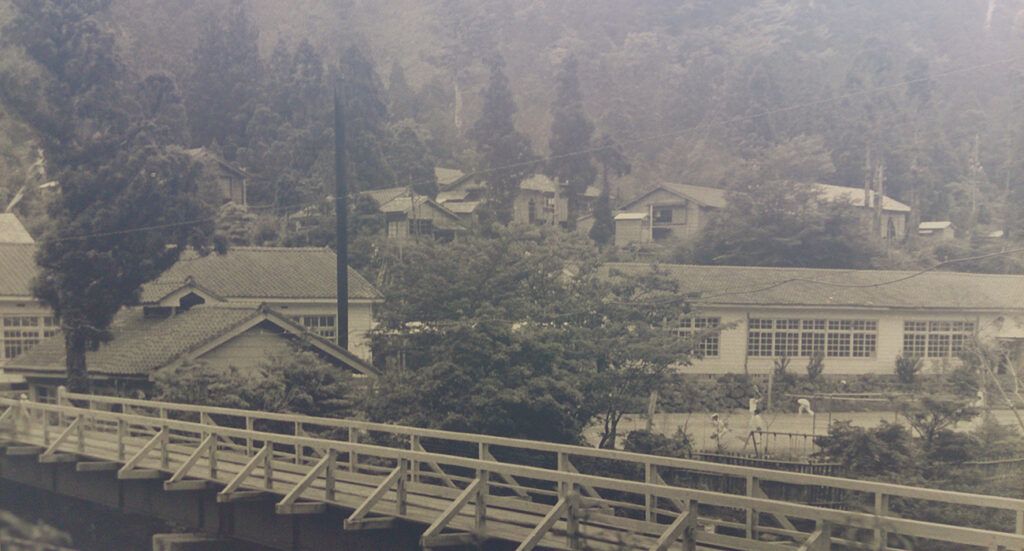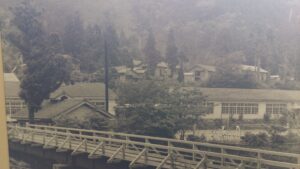THE HISTORY
IN AND AFTER MODERN TIMES
From Deforestation To Conservation

Modern Period
The hiragi industry continued for hundreds of years and the tiles were still being produced until just after the Pacific War (1941 – 1945). Soon after the collapse of the Shogunate in 1868, the hiragi industry began to suffer from a lack of organization. The country had other things on its mind at the time. Throughout the Meiji Period land allocation was a topical issue and access to the interior of Yakushima was a confusing matter. The locals requested that the Government re-open the interior so as they could improve the economy of their island. Matters were settled in the 1910s and with the aid of National Government assistance the infrastructure to log the interior was set up very quickly in the early 1920s. The majority of trees in the interior region were felled after the Pacific War and especially after the introduction of the chainsaw in 1956. The trees were transported down to the coast and shipped off to the mainland. The village of Kosugidani (小杉谷) on the Jomon sugi trail, located deep in the interior of the island, was a village founded in the 1920’s on this trade. The logging in this area stopped in 1970 and the last villager left Kosugidani in 1972. The remains of the village walls and steps can still be found.
Agricultural History
By the end of the Edo period, sugar cane had become an important product grown on Yakushima as well as many other southern Japanese islands. However, after the Pacific War, with the arrival of cheaper sugar imports, the industry faded and had ceased by the 1970’s. It was during this time that the ponkan orange became the successor to sugar cane. Ponkan arrived to Yakushima from Taiwan in the late 1920’s and due to a limited seasonal harvest (only 4 weeks in December) then in the 1950’s the tankan orange was brought from Taiwan. The tankan harvest is from early February to late March. Nowadays the tankan orange numbers outweigh the ponkan harvest and the orange industry is the main source of income for Yakushima farmers.
Since the 1980s tea has been grown on Yakushima and it is becoming a major export from the island.
Fishing History
Fishing has always played an important part in Yakushima’s history. Although the current fishing industry is based around flying fish and mackeral, this hasn’t always been the case. Up until the Taisho Era (1912- 1926) skipjack tuna or bonito was the target catch. However, encroaching large fishing fleets from the mainland forced the village of Isso to consider catching a different fish and so they switched to catching mackeral. Flying fish are the main catch from the Anbo Port, but this fish was caught on a large-scale from the 1920`s when knowledge of a particular fishing technique was introduced by immigrants. So great were the numbers of flying fish that they could often be netted from the shore, but this is no longer the case.
Village Life
 The older villages on Yakushima give us some idea of what life was like on the island before the Pacific War. In Nakama (中間 – a village close to Kurio), Isso (一奏) and Kusugawa (楠川 – just south of Miyanoura) you will find small houses huddled together. In these villages many of the residents will have the same surname. Years ago, people rarely left their village as access from village to village was very difficult (either walking over the mountains or paying a fisherman if you could afford it). One reason to leave the village would be when a prayer had been answered and the villager would go on a pilgrimage to all the shrines on the island (shimamawari – 島周り). There was a tradition of hosting the pilgrim and creating life-long friendships between the pilgrim and the village host. But this tradition, like so many others, faded away after the Pacific War.
The older villages on Yakushima give us some idea of what life was like on the island before the Pacific War. In Nakama (中間 – a village close to Kurio), Isso (一奏) and Kusugawa (楠川 – just south of Miyanoura) you will find small houses huddled together. In these villages many of the residents will have the same surname. Years ago, people rarely left their village as access from village to village was very difficult (either walking over the mountains or paying a fisherman if you could afford it). One reason to leave the village would be when a prayer had been answered and the villager would go on a pilgrimage to all the shrines on the island (shimamawari – 島周り). There was a tradition of hosting the pilgrim and creating life-long friendships between the pilgrim and the village host. But this tradition, like so many others, faded away after the Pacific War.
After the Pacific War
Even after the Pacific War, when Japan experienced a great prosperous change, life on Yakushima improved only very slowly. There are currently residents on the island who can recall a time when they would have to walk for hours and hours to get to a shop. There was no electricity and most people lived a self-sufficient lifestyle. By the 1960’s and 1970’s, Yakushima was beginning to catch up with the mainland. Roads, power and a sewage system became the norm (it wasn`t uncommon for locals to make their own fertilizer from their own sewage up until the 1970`s). By the 1980’s tourism was beginning to show signs of it becoming a major source of income for the island and once UNESCO recognized Yakushima in 1993 as a World Natural Heritage Site of Natural Beauty then the number of tourists increased dramatically. By 2007, there were more than 300,000 visitors a year. After the ‘banking crisis’ of 2008, the number of tourists has steadily dropped to around 220,000 a year. But even with a drop of 50,000 visitors in 5 years, the annual number of visitors still puts a great strain on the island’s forests and mountains. A constant cause for concern is the sustainability of Yakushima’s tourist industry in a fragile natural environment. The current debate regarding the future of the island is the development of the Yakushima Airport. The plan is to extend the runaway to allow jets to land on the island (currently only propeller aircraft arrive). The reason is to encourage flights from Kanto (Tokyo) as about 60% of visitors to Yakushima come from this region. Having witnessed the great changes made on islands such as Ishigaki in Okinawa after the introduction of jet aircraft then the future of this beautiful island is a cause for concern.


